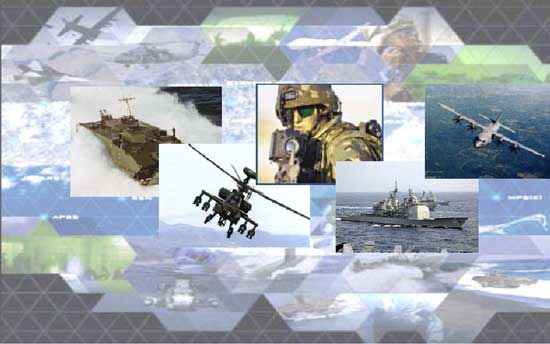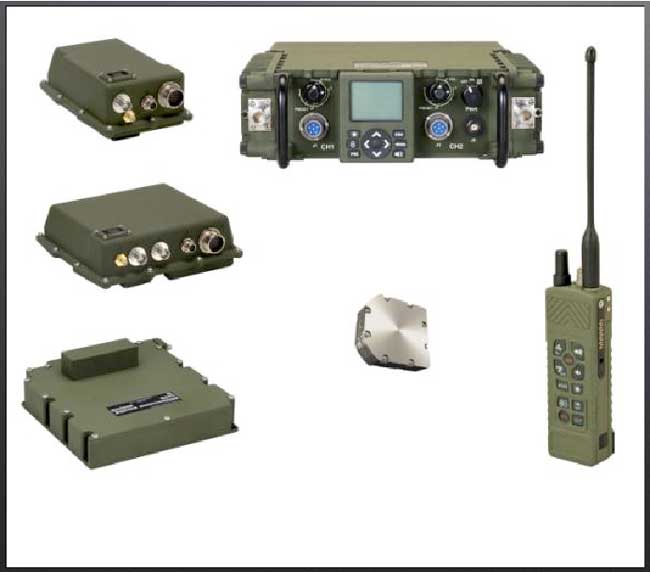Enabling Cost Effective Capability
02/24/2011 – In December, Second Line of Defense sat down with Marty Jenkins of Lockheed Martin to discuss the Airborne and Maritime/Fixed Station Joint Tactical Radio System or AMF JTRS. This is a significant program which can help re-shape interactive connectivity.
This is the third of a three-part interview. The full interview with comments is available in a Special Report which can be downloaded here……
SLD: With the JTRS infrastructure, we can re-work the relationships among the deployed platforms and have a more effective command structure mimicking what you described is how younger people organize themselves?
Marty Jenkins: We’re talking more distributed, collaborative command and control structure. With peer-to-peer networking, you enable all levels to have better visibility on what’s happening in the battle space. Better visibility on who from the U.S.-led coalition are in the area…and what they’re doing. And by sharing information in this high data rate collaborative environment, you’d also have a better picture of the enemy forces.
The commander is copying all of this networking peer-to-peer and can really enable command by negation; so the chain of Command can watch what’s going on rather having to ask for information and the direct specific actions; Commanders can be more of a coordinator, not only more efficient, but much more effective.
Because everyone has better visibility on what’s going on and who’s involved, you use your assets more effectively, more efficiently; you can save U.S. lives; you can kill or disable more of the enemy forces and you make much, much better use of your scarce resources.
SLD: And with this kind of capability, as I fold in the new assets like F-35 and LCS, and can shape new ways to use their capabilities.
Jenkins: Yes. Let’s talk air-to-air operations in a denied-access area. Right now you have aircraft that are designed primarily to go into denied-access areas in a flight of two or flight of four and network among themselves. Any information they generate on what’s happening on the ground or in the air is somewhat perishable and remains only with that flight.
If you see a mobile launcher on the ground it’s mobile, that information is perishable but in the current infrastructure you have almost no way to move that information out of the denied-access area and to someone who could make a decision or get another asset in or take an action to address something that that flight of two or flight of four has discovered That could range from a ballistic missile launch to a mobile SAM, to troops moving, to enemy ships with supersonic ship-killing missiles. hiding in merchant traffic.
 Mission of AMTRS: To develop and field interoperable, affordable, secure, wireless networking capabilities for the Joint Forces through an innovative enterprise business model. From JPEO JTRS Strat Plan 2010 (Credit: http://www.public.navy.mil/jpeojtrs/About%20JTRS/2010_Strat_Plan_May_24.pdf)
Mission of AMTRS: To develop and field interoperable, affordable, secure, wireless networking capabilities for the Joint Forces through an innovative enterprise business model. From JPEO JTRS Strat Plan 2010 (Credit: http://www.public.navy.mil/jpeojtrs/About%20JTRS/2010_Strat_Plan_May_24.pdf)
SLD: Because so much of this is machine driven, it could be thrown into various nodes that can deliver to different players in the actionable environment that you’re describing.
Jenkins: So if we looked at operations today, you have aircraft in flight that has a dedicated frequency on a dedicated hardwired radio that they’re using to communicate. If you don’t have connectivity from that radio to a node or people outside the area you’re in, you’re not going to be sharing that information. If information falls in the forest and you can’t get it to a decision maker, does it have any effect?
And the answer really is no, but, with AMF JTRS we want to have that flexibility in the future. So I don’t have a link network; I don’t have a C2 network; I don’t have an ISR network. I have a network where information can move pretty seamlessly from UHF to VHF to HF to EHF to CDL and the device will enable that by translating it, getting it to the right frequency, the right waveform, and the right path.
And suddenly the C2, the command and control of flights in the air, becomes similar to what it would be in the littoral or on the ground. That peer-to-peer information is now shared with a larger force in real time so that decisions can be made at a low level or at the commander level to prosecute or not, increase assets or not.
SLD: And if we go to the new platforms that are coming down, this can solve a couple crucial problems that F-35 should be an important army asset and it’ll be flying in battle space very significant to the ground fighter, but the way we set this up so far, the Army that will go out and buy redundant platforms.
If the data can be communicated to them, they’re not going to really care about the platform, which is delivering the information. But we’re going to have the F-35 in the battle space generating significant data relevant to the ground forces. So the Army is just cutting itself out of an enormous amount of data relevant to their survival and their viability if they don’t have this kind of JTRS infrastructure to deliver the data.
Jenkins: The F-35 is by far the most capable aircraft ever designed, ever being built; it has networking capabilities, information collection, and command and control capabilities that are almost serendipitous to the aircraft itself.
AMF JTRS can better enable current and future platforms to distribute the information in real time so that it can be triaged, analyzed, and used in near real time. Also, to connect troops on the ground to be able to communicate with each other or with air platforms, you’re going through a fairly laborious process with several communication nodes that must exist…and be preplanned to be in position…to operate at all.
SLD: Many gateways.
Jenkins: Gateways and relays, and a very laborious process. For example, in planning to support a SEAL team, a Marine unit, an Army unit, you’d have to preplan airborne assets to be able to make sure that you have connectivity even over a voice system or SINGARS (Single-Channel Ground-Air Radio System) or EPLRS (Enhanced Position Location Reporting System) to be able to communicate. EPLRS by the way goes through a satellite infrastructure that is used globally, so if you’re using it in theater, you could be standing in line behind somebody working at the National Training Center in California – it can be the same satellite, same channel. There is no prioritization. You might happen to be in a firefight and the satellite just takes whatever came first, processes that data; you could wait a couple of minutes for your information to process.

As AMF JTRS enables airborne, ground and ship IP infrastructure, JTRS becomes the gateway…as part of the design…that moves information in priority, picking best path to get to the destination instead of relying on a single path. And, as you populate operating forces with this capability, the need to preplan dedicated gateways well in advance is significantly reduced. Every JTRS node is a gateway and relay that creates the Network mesh. With IP enabled, web based planning; you can also modify network plans in stride, in real time. That may be as straightforward as frequency changes or as complex as moving assets slightly to create and broaden the mesh.
SLD: The point is it’s an infrastructure that’s platform agnostic.
Jenkins: Correct. AMF JTRS is platform agnostic. To see the advantages of IP systems to manage communications, you can go to the AT&T network operation center up in New Jersey; they’re a global network op center. They are monitoring their network – largely an IP network worldwide.
They’re not only able to have visibility on the network, they’re able to shift around so they can move things through an undersea cable or a satellite as the network gets saturated and they can be predictive. “By the way, watch in about 15 minutes the network’s going to get clobbered because American Idol’s on.” That kind of predictive ability and network visibility is central to their ability to manage their global network. And they do this with a small number of people.
SLD: And I am sure the military is not working with such a small number in the military sector.
Jenkins: For example, on a ship right now, on an aircraft carrier it probably has 35 sailors on watch in the communications spaces at any given time.
SLD: And these types of cost savings do not figure into GAO reports.
Jenkins: It is part of the problem of doing cost comparisons, when you do not look at manpower to manage communication networks or their effectiveness is using joint or coalition assets.
When we initially looked at cost comparison between JTRS devices, the comparison was with legacy radios. It’s like saying, “I’m going to make a cost comparison between my telephone and my computer.” It’s really not even apples and oranges, it’s more like fruit to vegetables; it’s a fundamental difference.
So when we look at total life cycle cost, we’re looking at the cost of a device itself, how long is it going to exist, what does it replace, what’s the maintenance cost, what’s the repair cost, what’s the cost in manpower and training, etc. If you just look at a single variable, and say, “We’re bringing in a device that can replace multiple legacy radios”, you’ve missed the rest of the story. Although, replacing legacy radios is an important factor. Right now on a Navy ship, you’d find many single purpose radios. With AMF JTRS devices that do multiple channel, multi-frequency with a lot of built in agility, the reductions in current inventory of single-focus radios goes way down. The focus shifts from boxes to channels…and you might be able to replace several legacy radios with one AMF JTRS device.
SLD: And there are the logs issues, including parts and training.
Jenkins: The training. Exactly. But it’s more than that because right now the cost and fuel and time of having assets that are either dedicated relays or prepositioned gateways costs flight time, fuel, etc.
With JTRS, I can do a lot more mission with the assets I have in any given timeframe or I can do the same mission with a lot less platform assets; it saves money, fuel, time, and it’s more than just the total life cycle cost of the device.

